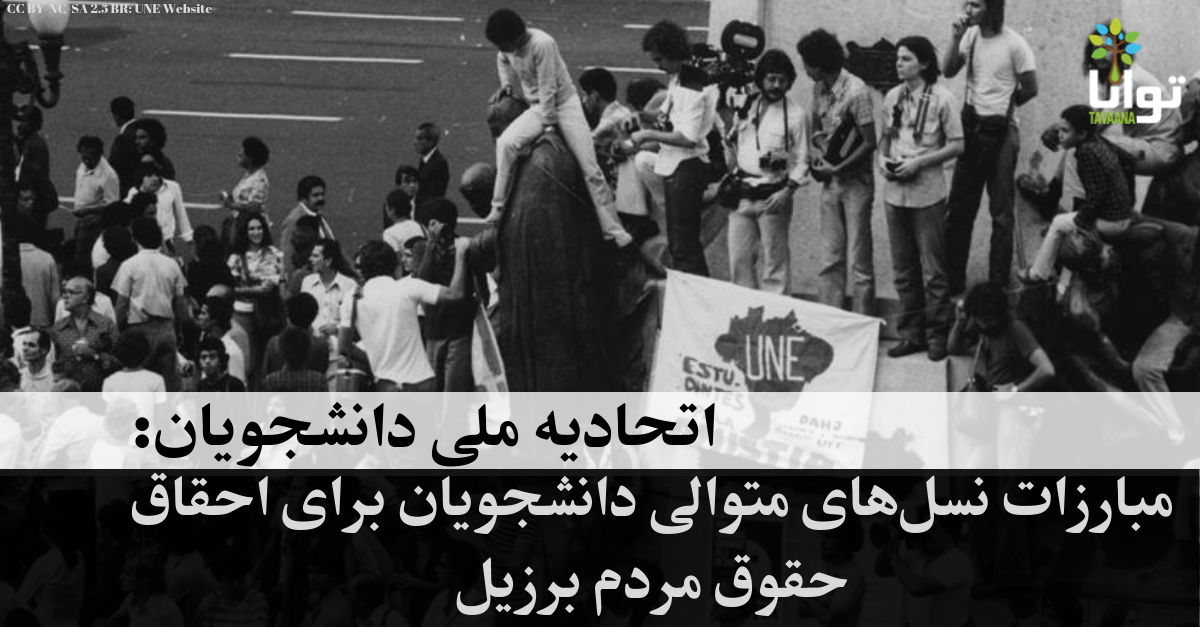“I realized early on that bullies would find a reason to pick on anyone. They called the smart kids “nerds,” the tall kids “bird legs” and the short kids “runts.” If perfect people existed, bullies would probably mock them for being too perfect.”
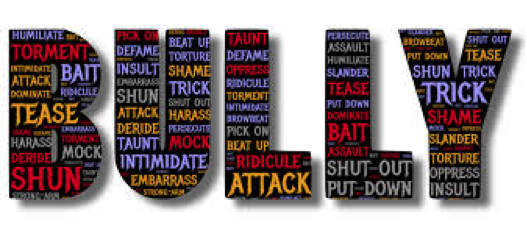
– Nick Vujicic, motivational speaker and anti-bullying campaigner.[1]
It’s not far, just a few blocks, but already he’s shaking, walking quickly, head down, hoping just for once to be invisible. He stops, stares, breathing faster as he sees the scuffle up ahead. “Don’t even think about watching,” a voice threatens, “Or I’m gonna throw you on the ground and start kicking you. I’ll break your Adam’s apple,” he adds softly, “which will kill you.” It’s barely 8 am, the school bell hasn’t rung yet, but already the relentless bullying has begun for 12-year old Alex Libby.[2]
Soon after starting middle school in suburban Iowa, Alex’s morning bus ride degenerated into a barrage of punching, strangling and endless taunts. “I just cried and said, ‘what if he decides he doesn’t want to be here anymore?’” Alex’s mother recalled later, “He didn’t have any friends. He was fading and we just couldn’t bring him back.” School intervention also seemed fruitless. “Now, I’ve ridden the 54 [bus],” the headteacher reassured Alex’s parents, “ [the kids] are just as good as gold.” “Buses are notoriously bad places for lots of kids,” she soothed patronizingly, “You know, I wish I could say I could make it stop, but I’m not gonna lie to you.”[3] Documentary filmmaker Lee Hirsch, however, disagreed.
Painstakingly filming Alex every day for months, Hirsch vividly captured both the bullying and the school’s indifference in agonizing detail, shocking even Alex’s own parents. Weaving Alex’s story together with those of other ordinary teens, Hirsch created the hard-hitting BULLY documentary, an unsettling portrait of the bullying epidemic gripping America’s schools, determined to start a revolution. “We had this idea that if we could get a million kids to see the film…” Hirsch explained passionately, “that that would create an undeniable ripple and that would be very much like a tipping point in our country.”[4]
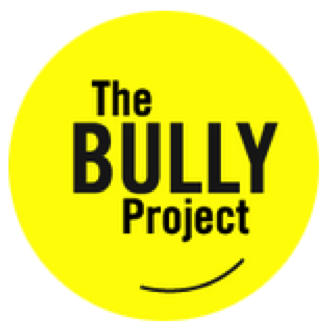
Five years on, over a million children in 17 countries have seen the documentary, with even the White House hosting a screening, but Hirsch is aiming higher still and has vowed to make it to ten million.[5] For Alex, the effect was electric, transforming him from voiceless victim to tireless anti-bullying advocate. “I like helping people. I make people realize they’re not alone,” he says fervently. “They have a beauty inside them. They just got to let that shine.” Surrounded by friends and powerfully addressing packed assembly halls, all traces of the dejected, hesitant teenager are gone. “Most of the shy kids out there, they are afraid that they will get picked on if they actually show who they really are,” he tells one crowd. “Being me, I learned that it wasn’t me. It was them.”[6]
Alex is far from alone, with thousands of students from India[7] to Kenya[8] regularly feigning illness to evade their bullies. Hanging themselves with skipping ropes, dog leashes and pajamas, and often leaving heart rending notes packed with anguish, countless children across the globe commit “bully-cide.”[9] In Japan, teen suicides spike dramatically every year on September 1, the first day of the new school term.[10] Now campaigners are demanding that it must be stopped. Working together with teachers and students, communities worldwide are using legislation, education and sheer determination to fight back.
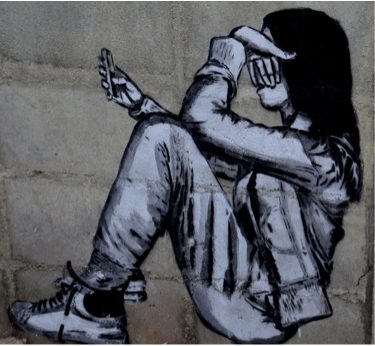
Bully v. Victims: Can the courts eliminate bullying?
One dreary October evening, three weeks and a day before her 14th birthday, Megan Meier angrily slammed her bedroom door. Twenty minutes later she was dead, hanged in her own closet. Driven to suicide by the vitriolic online behavior of one of her MySpace acquaintances, Megan was never to know that her tormentor was merely a vindictive fabrication of a former friend’s parents.[11] Five states away in central California, 13-year old Seth Walsh was chronically mocked for his mannerisms and clothing, and he too hanged himself from the family’s plum tree in September 2010.[12] Devastated, their families lobbied for tougher laws to protect teenagers, with Sacramento pushing through “Seth’s law” to update school bullying policies to better protect minorities, and Missouri enacting “Megan’s law,” targeting cyberbullying.[13] Similar tragic legacies are scattered throughout federal legislatures, with all 50 US states passing anti-bullying laws.[14] Many, however, question their efficacy.
Even the legal definition of “bullying” has proved challenging enough, with no two U.S. states using exactly the same terminology.[15] Derided by critics as “just pieces of paper,”[16] most states simply demand schools adopt a bullying prevention policy,[17] but tougher measures can also prove controversial. Zero-tolerance schemes led to the expulsion of one student for making a list of his enemies, and another for writing an English assignment about his thoughts on getting revenge on his bullies.[18] Worse still, attempts to supplement moderate anti-bullying policies with teacher training have often been watered down in state budget cuts. Unsurprisingly, bullying rates remained unchanged between 2005 and 2011 despite a flurry of new legislation.[19]
Pilot schemes in Australia and the UK have tried an alternative approach, granting power not to states but to students through school “bully courts.” Here, those accused of bullying are tried by a jury of their peers. Presided over by teachers, but administered by students, these courts assess the veracity of each claim and impose sanctions if required, with separate penalties for wasting the court’s time with false accusations. One bullying ringleader agreed to act as a bodyguard for his former victim while others wrote letters promising not to repeat the behavior.[20] While these courts have shown some success, their legalistic rationale has been challenged more broadly. “The truth is that you can’t neatly divide the world into aggressors and victims,” argues anti-bullying campaigner Barbara Coloroso, “Many children have the potential to be the school bully… bullies don’t come out the womb as bullies.”[21]

When 11-year old Ty Smalley became the latest bullycide victim, his distraught father did not make a law, but a promise. As Father’s Day loomed a month after his son’s death, Kirk Smalley lay awake, overwhelmed by a conviction that he had to do something. As the dreaded day dawned, he promised Ty to end bullying in the world. Just weeks later the powerful anti-bullying campaign “Stand for the Silent” was born. “I don’t break promises,” Kirk explains determinedly.[22] Started by 68 high schoolers, the organization uses Ty’s story to explain the cost and consequences of bullying, with dramatic effect. “Dear Mr. Smalley, I’m so sorry for the loss of your child. We will help stop bullying,” reads one letter, “…not too long ago I bullied someone and didn’t even know I was. But I was. And thanks to you, I changed that.”[23]
Despite its humble beginnings, the campaign has reached over a million students globally. “This is where worldwide organization takes place,” Kirk smiles, gesturing to the laptop on the sofa of his rural Oklahoma home. “For a guy that just got on the Internet about six weeks ago, it’s a pretty amazing thing.”[24] He encourages schools to start their own chapter of Stand for the Silent to allow students themselves to “make a change in their hallways and in their community.” With 365 chapters from India to Iceland, the movement is growing exponentially. “We go and we light a little spark,” Kirk explains, “They blow it into a big fire, and they just keep it going and going and going.”[25]
Tackling bullying, Kirk firmly believes, should not involve demonizing bullies, but building self-esteem and working together as a community. “How many of you in here right now are bullies?” shouts Kirk to one crowd. “I love you. You are somebody.” He continues, “Let’s be real. Your school can’t stop bullying. They can’t do it. They can help you. They can support you. They can’t stop this. Only you can.” “The main part of our message,” he explains, “is not to stand silent and watch it happen.”[26] Psychologists agree, urging campaigners to look beyond the bullies and the bullied to the bystanders.
Challenging Stereotypes: The not so innocent bystanders
“Thou shalt not stand idly by. The opposite of love is not hate, but indifference; indifference creates evil. Hatred is evil itself. Indifference is what allows evil to be strong, what gives it power.”
– Elie Wiesel, Holocaust survivor and writer.[27]
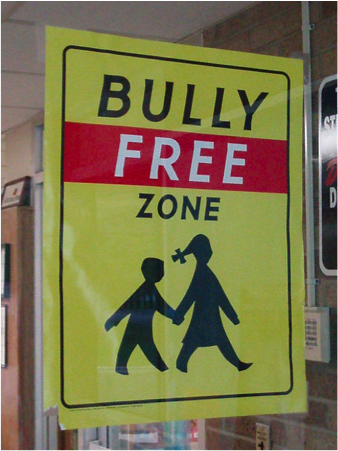
“DOOMED,” screamed the New York Post headline one mild morning in December 2012, “Pushed on the subway track, this man is about to die.” It was no exaggeration. The accompanying full-size photo captured the scene in lurid detail, illustrating the man’s final unsuccessful attempts to escape the oncoming train. Most shockingly of all in the minutes between his fall and death, not one other person, nor the photographer, intervened.[28] The explanation: the bystander effect.
Well documented in social psychology, this phenomenon explains the failure of crowds to assist those in danger. Alone, any one individual may rush to help a stab victim or a drowning child, but grouped together they become strangely passive. Responsibility, it seems, is sliced so thinly between the watching crowds that it evaporates to a vanishing point, justifying inaction. It is commonly observed in the bullying context, with one study demonstrating that peers only intervened in 13% of bullying episodes and actually reinforced it in over 80% of cases.[29]
In the fickle world of playground politics where “popular” can easily become “pariah,” the bystander effect becomes more complex as spectators fear that intervention could lead to victimization. In a school environment where popularity is highly prized and intervention rarely rewarded, students have little incentive to jeopardize their social status and risk being branded outcasts. “If it was up to me, if I was the king of the United States,” explains Ty Smalley’s closest friend firmly, “I’d make it [so] there was no popularity, everyone was equal, because that’s how it should be.”[30]
Undoubtedly, unhealthy social competition often drives bullying, but one new initiative is harnessing the power of this popularity pecking-order to change school culture through training students. “It’s these kids,” explains one researcher, “not the principal or the random outside speaker up on stage at an anti-bullying event, who students look to for their guidance about what’s acceptable within their community.”[31]
By meticulously mapping schools’ social networks through a series of detailed questionnaires, researchers are able to identify the most socially influential students. Working together with psychologists, these students outline sources of conflict, design posters and develop rewards to incentivize positive behavior. “Having students drive the intervention is crucial not only because of the sincerity and authenticity of the message,” explains assistant sociology professor Hana Shepherd, “but also because the content needs to be unique to each school.”[32]
Teachers and Parents: The bullying first responders
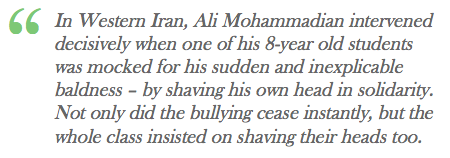
With their unique insights into classroom dynamics, teachers too can fight bullying. In Western Iran, Ali Mohammadian intervened decisively when one of his 8-year old students was mocked for his sudden and inexplicable baldness – by shaving his own head in solidarity. Not only did the bullying cease instantly, but the whole class insisted on shaving their heads too, with Ali’s example praised by the president and the Education Minister. “I’m so happy that this has touched many hearts, and people reacted enormously positively,” he explains excitedly. “Everyone in the school now wants to shave their head.”[33]

Meanwhile in the US, as Americans angrily condemned lax bullying policies and gun controls following the 1999 Columbine High School massacre, one math teacher quietly asked her students to make a list. Every Friday afternoon the children anonymously wrote down four students they’d like to get to know better, alongside their nomination for “classroom citizen of the week.”[34]
It was the marginalized students, those who never featured on these lists, who she monitored closely. Students may be too intimidated to report bullying, but “the truth comes out on those safe, private little sheets of paper.” “[Teachers] are the first responders, the front line, the disconnection detectives…” writes blogger Glennon Doyle Melton, “What [they] do in that classroom when no one is watching – it’s our best hope.”[35] However, as technology is shifting bullying out of the classes and onto the internet, parents too must help curb negative behavior.
‘Face’ is everything in Singapore’s fashion-conscious city-state. Gleaming weight-loss clinics and Chinese acupuncturists compete for the well-heeled clientele, while impeccably dressed teenagers snap selfies in exclusive malls to outdo their Facebook friends. Unsurprisingly, this fiercely competitive culture can turn toxic. Singapore has the highest cyberbullying rate in the world after China, with a quarter of secondary school students spreading rumors on social media or circulating defaced photos.[36]
While the cyberbullies may be invisible, the consequences are not, with numerous teens developing eating disorders and even committing suicide following endless online taunts. “On the Internet, the taunting and rumors can be relentless over 24 hours,” explains Touch Cyber Wellness’s assistant manager Chong Ee Jay. “The potential audience is much wider and so the shame or emotional trauma suffered can be more intense than actual physical injuries.” With freedom of expression strictly curtailed by the ruling People’s Action Party, netizens often resort to venting their frustrations online. However, with bullying this “cloak of anonymity” can prove dangerous, turning “the mildest of people into bullies because they feel emboldened and powerful.”[37]
Singapore’s 2014 Protection from Harassment Act criminalizes cyber-harassment and the bullying of children,[38] but many believe real change starts at home. “Parents play a critical role in shaping their children’s values,” believes Deputy Education Director Wong Siew Hoong, “as well as in guiding their online behavior, and monitoring their computer use.“[39] C-Quest, an engaging app game, has been designed by the Ministry to Education to help parents teach respectful online etiquette. “Educating children to become responsible users of social media through a game is definitely more effective than having a lesson in a classroom,” explains one satisfied mother.[40]
Together, ordinary teachers, dedicated parents and countless students are engaging millions in the campaign to end the global bullying epidemic. Alex Libby continues to share his story to packed assembly halls and Kirk Smalley has vowed to “fight bullying forever because [his] son will be 11 years old forever.”[41] The stakes are high; not only because countless teens are dying needlessly, but because bullying has no borders and extends far beyond the classroom walls.
Learn more
Books
Coloroso, Barbara. The Bully, the Bullied, and the Bystander: From Preschool to High School-How Parents and Teachers Can Help Break the Cycle. William Morrow Paperbacks, 2009.
News and Analysis
Temkin, Deborah. “All 50 States Now Have a Bullying Law. Now What?” The Huffington Post. 27 Apr. 2015. Web. 16 May 2016. <http://www.huffingtonpost.com/deborah-temkin/all-50-states-now-have-a_b_….
Dehoyos, Kathryn. “Kirk Smalley Found A Mission After the Suicide of His Son.” The Good Men Project. 27 Feb. 2013. 16 May 2016.
“Want to End Bullying? Get the Popular Students to Help.” Huffington Post. 8 Jan. 2016. Web. 16 May 2016. <http://www.huffingtonpost.com/science-of-us/want-to-end-bullying-get_b_8….
Tai, Janice. “1 in 4 Secondary Students ‘admits to Cyber Bullying'” The Straits Times. 14 July 2014. Web. 16 May 2016. <http://www.straitstimes.com/singapore/education/1-in-4-secondary-student….
It’s a Short Walk from Bullying to Genocide.” Canada.com. 28 Oct. 2007. Web. 16 May 2016. <http://www.canada.com/story_print.html?id=d42ca921-3aad-40d5-a5b7-788d29….
Alexander, Bryan. “The Bullying of Seth Walsh: Requiem for a Small-Town Boy.” TIME. 2 Oct. 2010. Web. 16 May 2016. <http://content.time.com/time/nation/article/0,8599,2023083,00.html>.
Henry, Julie. “Bullies to Be Judged by Their Victims and Classmates in School ‘courts'” The Telegraph. 18 May 2003. Web. 16 May 2016. <http://www.telegraph.co.uk/news/uknews/1430414/Bullies-to-be-judged-by-t….
Videos
Bully. Dir. Lee Hirsch. Perf. Alex Libby and Kirk Smalley. The Weinstein Company.
The Bully Effect.” Anderson Cooper 360 Degrees. CNN
From School Yard Bullying to Genocide: Barbara Coloroso at TEDxCalgary <http://tedxtalks.ted.com/video/From-School-Yard-Bullying-to-Ge>.
Footnotes
[1] Vujicic, Nick. Stand Strong: You Can Overcome Bullying (and Other Stuff That Keeps You Down). WaterBrook, 2015. Print.
[2] Bully. Dir. Lee Hirsch. Perf. Alex Libby and Kirk Smalley. The Weinstein Company, 2011.
[3] Ibid.
[4] “The Bully Effect.” Anderson Cooper 360 Degrees. CNN. 28 Feb. 2013. Web. 15 May 2016. Transcript
[5] “The Bully Project.” The Bully Project. Web. 15 May 2016.
[6] The Bully Effect, 4.
[7] Vyas, Hetal. “Breathless: Teens Faking Illness Soar.” Bangalore Mirror. 27 Dec. 2013. Web. 15 May 2016. <http://www.bangaloremirror.com/bangalore/cover-story/Breathless-Teens-fa….
[8] Okoth, Edwin. “Bullying Was Considered a Way of Toughening You up.” Knowledge Bylanes: News from Kenya. 9 Feb. 2015. Web. 15 May 2016. <http://www.knowledgebylanes.co.ke/bullying-was-considered-a-way-of-tough….
[9] Coloroso, Barbara. The Bully, the Bullied, and the Bystander: From Preschool to High School-How Parents and Teachers Can Help Break the Cycle. William Morrow Paperbacks, 2009. Print.
[10] Oi, Mariko. “Tackling the Deadliest Day for Japanese Teenagers.” BBC News. 31 Aug. 2015. Web. 15 May 2016. <http://www.bbc.com/news/world-asia-34105044>.
[11] “Megan’s Story.” Megan Meier Foundation. Web. 15 May 2016. <http://www.meganmeierfoundation.org/megans-story.html>.
[12] Alexander, Bryan. “The Bullying of Seth Walsh: Requiem for a Small-Town Boy.” TIME. 2 Oct. 2010. Web. 16 May 2016. <http://content.time.com/time/nation/article/0,8599,2023083,00.html>.
Gould, Jens Erik. “Seth’s Law: Can a Bullied Boy Leave California a Legal Legacy?” TIME. 5 Aug. 2011. Web. 16 May 2016. <http://content.time.com/time/nation/article/0,8599,2086521,00.html>.
[13] “Megan’s Law.” The Economist. 9 July 2009. Web. 16 May 2016. <http://www.economist.com/node/14002757>.
[14] Temkin, Deborah. “All 50 States Now Have a Bullying Law. Now What?” The Huffington Post. 27 Apr. 2015. Web. 16 May 2016. <http://www.huffingtonpost.com/deborah-temkin/all-50-states-now-have-a_b_….
[15] Ibid.
[16] Crawford, Leslie. “Standing up for His Son.” Great!Kids. Web. 16 May 2016. <http://www.greatschools.org/gk/articles/a-father-fights-bullying/>.
[17] Temkin, 14.
[18] Coloroso, 9.
[19] Temkin, 14.
[20] Henry, Julie. “Bullies to Be Judged by Their Victims and Classmates in School ‘courts'” The Telegraph. 18 May 2003. Web. 16 May 2016. <http://www.telegraph.co.uk/news/uknews/1430414/Bullies-to-be-judged-by-t….
[21] Temkin, 14.
[22] Dehoyos, Kathryn. “Kirk Smalley Found A Mission After the Suicide of His Son.” The Good Men Project. 27 Feb. 2013. Web. 16 May 2016.
[23] The Bully Effect, 4.
[24] Bully, 2.
[25] The Bully Effect, 4.
[26] Ibid.
[27] “How to Help Student Bystanders Become “Upstanders.”” BRIM Anti-bullying Software. Web. 16 May 2016. <https://antibullyingsoftware.com/how-to-encourage-bystanders-to-report-b….
[28] Honan, Daniel. “Would You Save This Man’s Life? The Bystander Effect Revisited.” Big Think. Web. 16 May 2016. <http://bigthink.com/think-tank/would-you-save-this-mans-life-the-trolley….
[29] Coloroso, 9.
[30] Bully, 2.
[31] “Want to End Bullying? Get the Popular Students to Help.” Huffington Post. 8 Jan. 2016. Web. 16 May 2016. <http://www.huffingtonpost.com/science-of-us/want-to-end-bullying-get_b_8….
[32] Ibid.
[33] Dehghan, Saeed Kamali. “Hairless Hero: Iranian Teacher Shaves Head in Solidarity with Bullied Pupil.” The Guardian. 28 Jan. 2014. Web. 16 May 2016. <http://www.theguardian.com/world/iran-blog/2014/jan/28/iranian-teacher-h….
[34] Melton, Glennon Doyle. “Share This with All the Schools. Please.” Momastery. 30 Jan. 2014. Web. 16 May 2016. <http://momastery.com/blog/2014/01/30/share-schools/>.
[35] Ibid.
[36] Tai, Janice. “1 in 4 Secondary Students ‘admits to Cyber Bullying'” The Straits Times. 14 July 2014. Web. 16 May 2016. <http://www.straitstimes.com/singapore/education/1-in-4-secondary-student….
[37] Ibid.
[38] Palatino, Mong. “Singapore Criminalizes Cyber Bullying and Stalking.” The Diplomat. 24 Mar. 2014. Web. 16 May 2016. <http://thediplomat.com/2014/03/singapore-criminalizes-cyber-bullying-and….
[39] Tan, Emilia. “MOE Launches Cyber-wellness App for Parents and Children.” Today. 20 Sept. 2014. Web. 16 May 2016. <http://www.todayonline.com/singapore/moe-launches-cyber-wellness-app-par….
[40] Ibid.
[41] Bully, 2.




